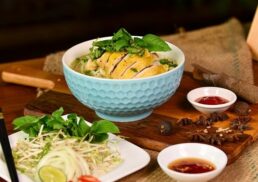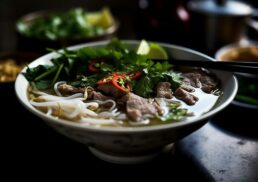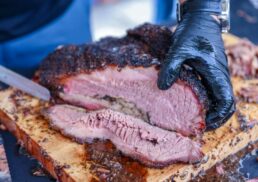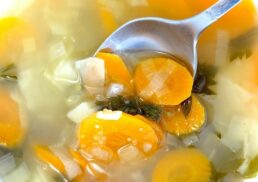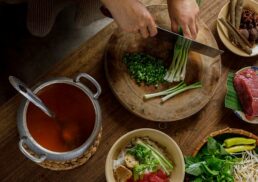Korean barbecue is taking the world by storm, and it’s no surprise why! With sizzling meats, mouthwatering sauces, and vibrant side dishes, the flavors and communal experience of Korean barbecue are truly unforgettable. In this guide, we’ll explore the essential elements of Korean barbecue, from the star meats to the art of wrapping, that will have you mastering this beloved culinary tradition in no time.
Table of Contents
Key Takeaways
Experience the tantalizing flavors of Korean BBQ with delicious beef, pork and chicken dishes!
Enhance your meal with an array of flavorful sauces & ssamjang plus unique side dishes like banchan & rice.
Quench your thirst while exploring stews to take it to the next level, make it truly unforgettable!
The Stars of Korean Barbecue: Meat Choices

At the heart of every Korean barbecue feast lies a tantalizing array of meats, with beef, pork, and chicken being the most popular choices. Each type of meat introduces its unique flavors and textures, while marination and grilling techniques significantly enhance these qualities. For a genuine Korean BBQ experience, using high-quality ingredients and adhering to the correct grilling methods is vital.
When it comes to marinating the meats, traditional Korean ingredients like soy sauce, sesame oil, and Korean pear create a symphony of flavors that will leave your taste buds dancing. As you prepare the grill, brush some oil or rub fattiest meat like thinly sliced beef to ensure the meats cook evenly and to prevent sticking. And don’t forget to cut the cooked meat into bite-size pieces using scissors, as they do in Korean barbecue restaurants.
Let’s delve into the variety of meats used in Korean barbecue and the dishes that highlight their irresistible flavors.
Beef: From Bulgogi to Galbi
Beef is a staple in Korean barbecue, with scrumptious dishes like bulgogi and galbi taking center stage. Bulgogi, which translates to “fire meat,” features tender, marbled beef marinated in a sweet, gingery sauce. To achieve the perfect bulgogi, use high-quality cuts like sirloin, tenderloin, or skirt steak, and thinly slice the meat against the grain. Grilling over charcoal is ideal, as it imparts a delightful smoky flavor to the dish.
Galbi, another must-try beef dish, consists of:
Marinated beef short ribs that are packed with flavor and tender goodness
The ribs are typically marinated in a soy sauce-based mixture with toasted sesame oil, Asian pear, brown sugar, and mirin, creating a sweet and savory symphony that will make your mouth water
LA-style, flanken-cut short ribs are the preferred cut, but if unavailable, experiment with cuts that suit your grill setup at home.
Upon mastering these beef dishes, you’re on the path to becoming a Korean barbecue expert. Now, let’s turn our attention to the realm of piquant pork dishes, sure to invigorate your taste buds!
Pork: Savoring Spicy Dwaeji Bulgogi
Spicy dwaeji bulgogi, a popular pork dish in Korean barbecue, is the perfect choice for those who crave bold flavors and succulent grilled meats. The key to this dish lies in its tantalizing gochujang-spiked marinade, which infuses the pork with a fiery kick. To ensure the tastiest results, opt for cuts of pork with a good amount of fat, such as pork belly or Boston butt, sliced into half-inch-thick pieces.
The marinade for dwaeji bulgogi is a true flavor bomb, combining ingredients like:
Crushed Korean pear
Onion purée
Minced garlic
Minced ginger
Gochugaru
Gochujang
Soy sauce
Mirin
Sesame oil
Brown sugar
Black pepper
Once marinated, the pork is ready to hit the grill, which should be heated to a medium/high heat for optimal cooking.
Dwaeji bulgogi is a must-try for anyone looking to add some heat to their Korean barbecue experience. But don’t worry, we haven’t forgotten about the poultry lovers out there. Next, let’s venture into the realm of fiery chicken dishes that won’t fail to impress.
Chicken: The Fiery Flavors of Buldak
Buldak, translating to “fire chicken,” is a deliciously spicy-sweet chicken dish that brings a whole new level of excitement to Korean barbecue. Another popular Korean chicken dish is chicken bulgogi, which is known for its savory and slightly sweet flavor. When preparing buldak, chicken thighs are the preferred cut, offering the perfect balance of flavor and tenderness. The chicken is then marinated in a delectable sauce, featuring ingredients like:
water
artificial chicken flavor
corn syrup
soy sauce
soybean oil
onion
garlic
decolorized chili extract
paprika
Once marinated, it’s time for the chicken to sizzle on the grill. The key to perfect buldak is to cut the meat into bite-size pieces using scissors as it cooks, ensuring even cooking and easy consumption. With its fiery flavors and succulent texture, buldak is sure to be a hit at your next Korean barbecue feast.
Enhancing the Experience: Sauces and Ssamjang

No Korean barbecue experience is complete without the accompaniment of flavorful sauces and ssamjang. These essential elements add depth and complexity to the grilled meats and vegetables, elevating the dining experience to new heights.
Ssamjang, a delicious dipping sauce, is a combination of:
Doenjang
Gochujang
Toasted sesame oil
Sesame seeds
Fresh garlic
Scallions
This creates a harmonious blend of flavors that will have you coming back for more.
In addition to ssamjang, there are other popular Korean BBQ dipping sauces, such as wasabi and soy sauce, and sesame oil, salt, and pepper sauce. These sauces not only add an extra layer of flavor to the wraps but also help to highlight the unique characteristics of each meat and vegetable.
Whether savoring beef galbi or spicy pork, remember to try an array of sauces and ssamjang. These potent flavor enhancers are sure to render your Korean barbecue experience unforgettable.
Wrapping It Up: Lettuces and Perilla Leaves
Lettuces and perilla leaves play a vital role in Korean barbecue, serving as refreshing wrappers for the grilled meats and ssamjang. These leafy greens provide a crisp and light contrast to the rich, flavorful meats, creating a delightful balance of textures and flavors in each bite.
Perilla leaves, which belong to the mint family, offer a unique slightly anise-y flavor that adds an extra dimension to the barbecue experience. Wash and dry the lettuce and perilla leaves thoroughly. Store them on a platter under a damp paper towel in the fridge..
With these crisp and refreshing wrappers in hand, you’re ready to build the perfect ssam – a mouthwatering combination of grilled meat, ssamjang, and leafy greens that will leave you craving more.
Flavorful Additions: Ssam Garnishes
To further enhance the flavors of Korean barbecue, ssam garnishes are sprinkled into lettuce wraps or perilla leaves filled with grilled meats and ssamjang. These flavorful additions include:
Thinly sliced fresh green Korean chilies
Sliced garlic cloves
Scallions
Toasted sesame seeds
These garnishes add extra dimensions of flavor and texture to each bite.
Garlic, a popular ssam garnish, can be sliced and toasted on the grill or combined with oil and placed on the grill to create a bubbly, aromatic garlic oil for drizzling over the meats. These garnishes not only elevate the flavors of the meats but also add a touch of personalization to each wrap, making your Korean barbecue experience truly unique.
As you experiment with various ssam garnishes, you’ll discover a world of exciting flavor combinations that will keep your taste buds on their toes.
Exploring Banchan: Essential Side Dishes
Banchan, or side dishes, are essential to Korean barbecue, offering a variety of flavors and textures to complement the grilled meats and prevent palate fatigue. These small, yet oh-so-flavorful dishes are the perfect accompaniment to any Korean barbecue meal, providing a delightful contrast to the rich, savory meats.
Examples of banchan include:
Pickled and fermented vegetables
Marinated greens
Stir-fried dried anchovies
Rolled omelettes
These side dishes not only add visual appeal to the table but also play a crucial role in balancing the bold flavors of the meats, ensuring a well-rounded and satisfying dining experience.
During your next Korean barbecue feast, make sure to discover the universe of banchan. These requisite side dishes will elevate your meal experience, whetting your appetite for more culinary delights.
The Supporting Role: Rice in Korean Barbecue
Rice, often considered the backbone of Korean cuisine, plays a supporting role in Korean barbecue, providing a neutral base to balance the bold flavors of the meats and side dishes. Commonly used types of rice in Korean barbecue include short grain white rice (백미, bakmi) and short grain brown rice (현미, hyunmi).
Traditionally, rice for Korean barbecue is prepared by boiling it with the lid on for 5-10 minutes on high heat until the water is absorbed and the rice expands. This method ensures perfectly cooked, fluffy rice that is ready to serve alongside the sizzling meats and vibrant banchan.
While relishing the flavors of Korean barbecue, remember to appreciate the fundamental yet significant role of rice. This adaptable grain lays the groundwork for the plethora of flavors, guaranteeing a balanced and satisfying dining experience.
Quench Your Thirst: Pairing Beverages with Korean Barbecue
Pairing the right beverages with Korean barbecue can enhance the flavors and enjoyment of the meal. Popular alcoholic options to complement the grilled meats and side dishes include soju and beer, which are widely enjoyed in Korean culture.
Non-alcoholic options like lemonade and Coke can also be delightful accompaniments to Korean barbecue, providing a refreshing contrast to the bold flavors and helping to cleanse the palate between bites.
Whether your preference leans towards a chilled beer, a shot of soju, or a bubbly soda, selecting the optimal beverage to complement your Korean barbecue feast can uplift the experience, making it all the more unforgettable and pleasurable.
Going the Extra Mile: Incorporating Stews
Incorporating stews into your Korean barbecue experience adds another layer of depth and variety, making for a truly memorable dining experience. Stews, like yeomso tang or kimchi jjigae, bring a rich and hearty element to the table, perfectly complementing the grilled meats and elevating the overall dining experience.
Popular stews to incorporate into a Korean barbecue meal include:
Kimchi jjigae
Gamjatang
Doenjang jjigae
Budae jjigae
Maeuntang
These delicious stews often feature unique ingredients, such as perilla leaves or American processed meats, creating a fusion of flavors that is distinctly Korean. You can find these ingredients at a Korean grocery store.
Including stews in your Korean barbecue feast takes the dining experience a notch higher, leading to a culinary delight your taste buds will appreciate.
Summary
In conclusion, Korean barbecue is a vibrant and communal culinary experience that offers a tantalizing array of flavors, textures, and aromas. By mastering the art of Korean barbecue, from selecting the perfect cuts of meat to exploring the world of banchan and stews, you’ll be well on your way to creating unforgettable meals that will impress your friends and family. So, gather around the grill, and embark on a culinary journey that will leave you craving more.
Frequently Asked Questions
What is usually in Korean BBQ?
Enjoy the tastiness of marinated cuts like bulgogi and galbi (beef short ribs) and other delicious options like pork belly, beef tongue, chicken and intestines at Korean BBQ! These popular dishes are usually served with a sweet, soy sauce-based brine for added flavor.
What is a Korean BBQ grill plate called?
Treat yourself to an authentic Korean BBQ experience with a GuiGui or Grill Pan – perfect for grilling pork belly, beef, seafood, chicken and more.
What are the most popular meat choices in Korean barbecue?
Fire up the grill, it’s time to enjoy some of Korea’s most popular barbecue meats – beef, pork belly and chicken!
What is the role of sauces and ssamjang in Korean barbecue?
Sauces and ssamjang enhance the Korean barbecue experience, adding complexity and depth to the grilled meats and vegetables for an unforgettable meal.
How do lettuce and perilla leaves contribute to Korean barbecue?
Lettuce and perilla leaves add crunch and lightness to Korean barbecue, providing a delightful contrast to the grilled meats and ssamjang for a truly unique flavor experience!
